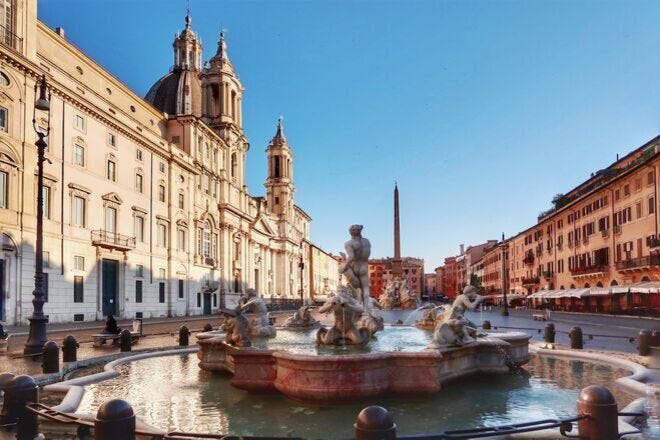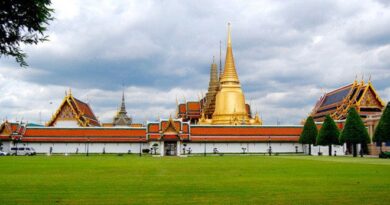Rome Historic Sites: 10Best Historic Site Reviews
If you’re looking for a quick and easy break to get away from the city, you might consider taking a day trip to Ostia Antica. Compared to Pompeii but much closer to Rome and far less crowded, you’ll witness ruins and relics that date back to the 4th century B.C. and ancient mosaics that date back to the 2nd century A.D. There’s also a lovely amphitheater that truly captures the richness of this magical ancient city! According to ancient legend, the town of Ostia was founded by the fourth kind of Rome, Ancus Marcius. Though no archaeological finds dating back to this period have been uncovered to date. Rather, the ‘Ostia Antica’ as we know it today dates back to the 4th century B.C. Ostia means “mouth” in Latin. As it was positioned at the mouth of the Tiber River, Ostia served as a seaport of Rome.
Recommended for Historic Sites because: Take a break from the city center and step back to the 4th century BC at the ruins of Ostia Antica.
Maria’s expert tip: To get there, you’ll want to hop on the Metro B line (direction Laurentina) and get off at the Piramide stop. Once you’ve gotten off at the stop, you’ll need to look for and follow the signs that read ‘ROMA-LIDO’. The good thing is that your bus pass allows you to travel on this line at no extra charge. This train typically runs every 15 minutes or so. Once you hop on the train, it will take you about 30 minutes to reach Ostia Antica. Make sure you get off at the 7th stop which is called ‘Ostia Antica.’ Once you get off at the Ostia Antica stop, as you exit the station, you’ll cross the pedestrian bridge until you reach a parking lot. Here you’ll need to make a left and almost immediately, you’ll see the entrance to the Ostia Antica archaeological park. To get into the park, you’ll need to pay 6,50 for a ticket. Keep in mind though, that the park is closed on Mondays.
For some of the best views of the Roman city skyline, it’s worth making the trip up to the top of the Janiculum Hill (Giancolo). The area is not too accessible by public transportation, but locals and tourists decide to walk up the winding road when touring the area of Trastevere, which makes the visit easier. Once you make it to the top of Via Giacinto Carini, make sure to have your cameras ready for that picture-perfect snapshot of the Vittoriano Monument, the Pincio Gardens, San Pietro in Montorio and other beauties. The Giancolo is not apart of the 7 famous hills of Rome. The Janiculum also houses the famous Baroque fountain called the Acqua Paola and several prestigious foreign institutions such as the American Academy of Rome which hosts academic scholars of the arts on fellowships and sabbaticals each year, the Spanish Academy and the American University of Rome. Make sure to pay a visit to the Villa Lante before you leave the area. BUS: 115 or 870 to the top or 44 and 75 to Via Giacinto Carini.
Recommended for Historic Sites because: Visit Giancolo for a view of Rome that will take your breath away.
Maria’s expert tip: Make sure to check out the afternoon puppet shows (Teatrino di Pulcinella) featured just North of Piazzale Garibaldi from 3 pm onwards. The shows are free, but a small donation is kindly accepted.
What today appears to be a large open field, was once a grandiose sporting arena (one of the largest in the world) during Imperial times. The Circo Massimo (Circus Maximus) was a facility that contained a seating capacity of more than 300,000 seats. The arena set between Capitoline and Palatine hill was Ancient Rome’s largest racetrack and was home for some of the most monumental chariot races. Some races would last up to two weeks at a time. Its length stretches some 650 yards from one end to the other. The arena went up in flames in 64 AD causing several thousands of casualties and left parts of the city destroyed. Today what’s left of the site remains a green open field where the Comune di Roma (City of Rome) puts on free concerts, art exhibitions and other cultural events. BUS: 160, 80 METRO: Circo Massimo.
Recommended for Historic Sites because: The Circus Maximus was Ancient Rome’s largest racetrack and nowadays serves as a market or concert space.
Maria’s expert tip: If you’re in the neighborhood, don’t forget to stop by Cristalli di Zucchero for some of their delightful mini decadent desserts!
After the Colosseum, the impressive Roman Forum is your next best introduction to Ancient Rome. From the entrance on Via Dei Fori Imperiali, one can take in the breathtaking views of the ancient ruins and relics left behind from the stomping grounds of Rome’s former emperors. The site started off as a simple valley between the Capitoline and Palatine Hills. It later became the heart of the city’s most important municipal buildings and a commercial center.
The ruins left behind today run a span of some 900 years from 500 BC to AD 400. BUS: 87, 571. METRO: Cavour; Colosseo
Recommended for Historic Sites because: Nowhere else in Rome will you feel as though you’re walking in former emperors’ footsteps.
Maria’s expert tip: After a day of touring the Roman Forum, head on over to La Base Ristorante on Via Cavour for a great plate of pasta, a juicy steak or even a pizza.
You can’t get anymore Baroque beautiful than Piazza Navona. This piazza has it all: three glorious fountains, Bernini sculptures, a lovely outdoor caf? scene and the magnificent Sant’Agnese in Agone church. In the first century A.D., this piazza was built over the Stadium where Emperor Domitian hosted chariot races and other contests. The most prominent of the fountains in the piazza is the Fontana dei Quattro Fiumi. Bernini created the fountain for Pope Innocent X in 1651. The fountain represents the four rivers and four corners of the world: the Nile; the Plata, the Danube and the Ganges. BUS 40, 64, 492, 30.
Recommended for Historic Sites because: The Bernini fountain and vibrant street artists make Piazza Navona a must-see.
Maria’s expert tip: Make sure to head on over to Frigidarium Gelateria located just around the corner from Piazza Navona on Via del Governo Vecchio.
Photo courtesy of Maria Pasquale
Ever since its completion in 1726, visitors even to this day are taken aback by the beauty of the Spanish Steps otherwise known as the ‘scalinata’ (staircase) to the locals. The three flights and landings represent the Trinity, and you almost feel as though you could be climbing toward Heaven’s Gates as you ascend. Once you reach the very top of the steps, the bird’s eye view of the Roman rooftops, the prestigious palazzi and the hustle and bustle of the piazza; you begin to realize just how stunningly beautiful Rome really is. BUS: 117, 119 or 590. METRO: Spagna
Recommended for Historic Sites because: Take a walk on the biggest staircase in all of Europe.
Maria’s expert tip: Recent new city rules prohibit sitting on the steps and can incur hefty fines. Walking up and standing on the stairs is fine.
Commonly referred to as the ‘mother of all churches,’ St. Peter’s Basilica was commissioned in 324 AD by Constantine as a church to be dedicated to the Apostle Peter. The church was reportedly built on the burial site of this most influential Christian, who was crucified upside down in the nearby Circus of Nero in 64 AD. The original church was destroyed in the 16th century, and the present church was built on the same site. Guided tours of excavations around Peter’s tomb are available. Fall and winter closures are about one hour earlier. It is also possible to visit the top of St. Peter’s dome by either climbing the stairs (about 500 steps) for 5 euro or taking the elevator all the way up for 7 euro. METRO: Ottaviano/San Pietro, BUS: 46, 64, 492.
Recommended for Historic Sites because: No building in Rome is taller than the beautiful dome of St Peter’s.
Maria’s expert tip: Make sure not to wear shorts or sleeveless shirts. If caught with bare shoulders or your knees showing, you will be denied entry into the basilica.
Thanks to Fellini’s Dolce Vita, the Trevi Fountain has served as a picturesque backdrop for Hollywood blockbusters like Three Coins in a Fountain and Roman Holiday and a dream come true for young women looking for love. Legend has it, throwing a coin into the Trevi Fountain, will ensure you a return trip to the Eternal City. The fountain is a dramatic aquatic marvel for visitors thanks to its vast basin ensconced between three tiny streets (the “tre vie,”) with cascades of water that appear to be streaming from the wall of Palazzo Poli. Believe it or not, the Trevi Fountain is quite the money maker. Authorities say it rakes in some 600,000 a year, all of which is donated to charity.
Recommended for Historic Sites because: No visit to Rome would be complete without tossing a coin into the Trevi.
Maria’s expert tip: Make sure you know how to toss the coin in the right way. Toss the coin with your right hand over your left shoulder and your back to the fountain. One coin means you’ll surely return to Rome. Two coins mean you’ll return to Rome and find love at last. Three coins mean, you’ll return to Rome and marry the love of your life.
One of the best-preserved monuments and best examples of Ancient Roman architecture in the city is the Colosseum. It took nearly ten years to build one of the world’s largest public venues: heroic arches, columns and windows that stood 160 feet high and a seating capacity of 50,000 which made this arena so immense and prominent. Construction of the arena was ordered by Vespasian in A.D. 72 and was inaugurated by Titus in A.D. 80 with combat games involving gladiators and animals. Aside from bloody battles, legend has it that Christians were also fed to the lions at the Colosseum. BUS: 87, 571. METRO: Colosseo
Recommended for Historic Sites because: The Colosseum remains one of the most recognizable monuments in the world.
Maria’s expert tip: Make sure to check out the Colosseum at night. The Moon Over Colosseum night tours takes place twice a week.
After the Colosseum, one of Rome’s best-preserved monuments is the Pantheon. It was originally meant to be a pagan temple only to be later converted into a church. The original rectangular facility, which was comprised of 16 granite columns, serves as the porch of the dome structure. The immense preserved building, located in Piazza Della Rotonda, makes photographs postcard perfect. To this day, engineers remain in awe of the unsupported dome structure and maintain it is impossible to replicate. The piazza where the Pantheon is located also happens to be a favorite hangout for young people and features many outdoor cafes. BUS: 40, 64, 46, 916
Recommended for Historic Sites because: Aside from being beautiful, the Pantheon is a great free site to visit.
Maria’s expert tip: Make sure to check out Rome’s famous coffee bar, Tazza d’Oro just around the corner on Via Dei Pastini.














